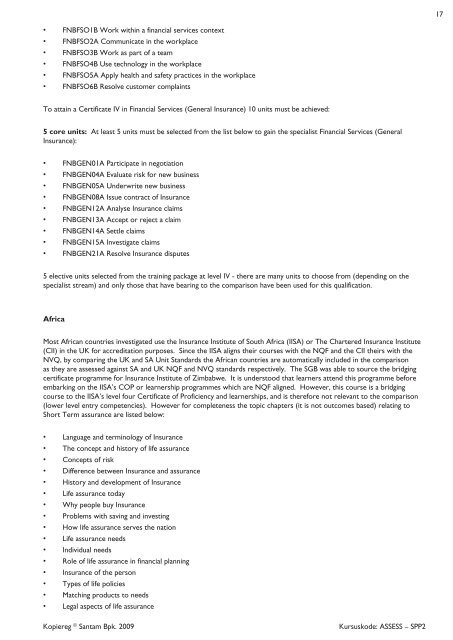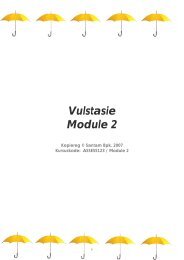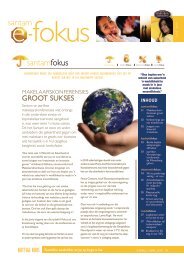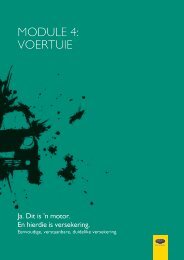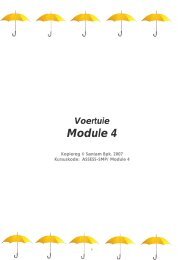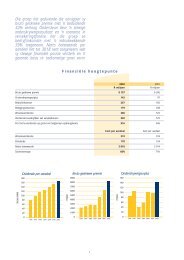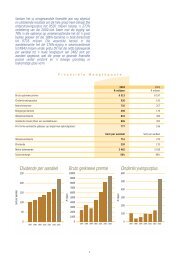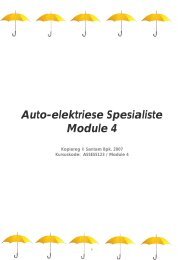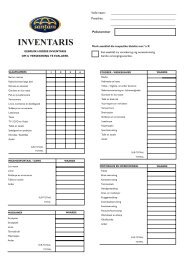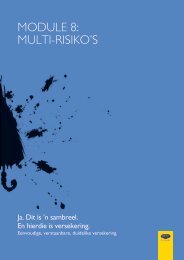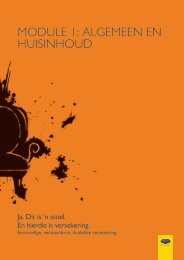Santam Se perSoonlike poliS WerkSopDraG
Santam Se perSoonlike poliS WerkSopDraG
Santam Se perSoonlike poliS WerkSopDraG
You also want an ePaper? Increase the reach of your titles
YUMPU automatically turns print PDFs into web optimized ePapers that Google loves.
•<br />
•<br />
•<br />
•<br />
•<br />
•<br />
FNBFSO1B Work within a financial services context<br />
FNBFSO2A Communicate in the workplace<br />
FNBFSO3B Work as part of a team<br />
FNBFSO4B Use technology in the workplace<br />
FNBFSO5A Apply health and safety practices in the workplace<br />
FNBFSO6B Resolve customer complaints<br />
To attain a Certificate IV in Financial <strong>Se</strong>rvices (General Insurance) 10 units must be achieved:<br />
5 core units: At least 5 units must be selected from the list below to gain the specialist Financial <strong>Se</strong>rvices (General<br />
Insurance):<br />
•<br />
•<br />
•<br />
•<br />
•<br />
•<br />
•<br />
•<br />
•<br />
FNBGEN01A Participate in negotiation<br />
FNBGEN04A Evaluate risk for new business<br />
FNBGEN05A Underwrite new business<br />
FNBGEN08A Issue contract of Insurance<br />
FNBGEN12A Analyse Insurance claims<br />
FNBGEN13A Accept or reject a claim<br />
FNBGEN14A <strong>Se</strong>ttle claims<br />
FNBGEN15A Investigate claims<br />
FNBGEN21A Resolve Insurance disputes<br />
5 elective units selected from the training package at level IV - there are many units to choose from (depending on the<br />
specialist stream) and only those that have bearing to the comparison have been used for this qualification.<br />
Africa<br />
Most African countries investigated use the Insurance Institute of South Africa (IISA) or The Chartered Insurance Institute<br />
(CII) in the UK for accreditation purposes. Since the IISA aligns their courses with the NQF and the CII theirs with the<br />
NVQ, by comparing the UK and SA Unit Standards the African countries are automatically included in the comparison<br />
as they are assessed against SA and UK NQF and NVQ standards respectively. The SGB was able to source the bridging<br />
certificate programme for Insurance Institute of Zimbabwe. It is understood that learners attend this programme before<br />
embarking on the IISA’s COP or learnership programmes which are NQF aligned. However, this course is a bridging<br />
course to the IISA’s level four Certificate of Proficiency and learnerships, and is therefore not relevant to the comparison<br />
(lower level entry competencies). However for completeness the topic chapters (it is not outcomes based) relating to<br />
Short Term assurance are listed below:<br />
•<br />
•<br />
•<br />
•<br />
•<br />
•<br />
•<br />
•<br />
•<br />
•<br />
•<br />
•<br />
•<br />
•<br />
•<br />
•<br />
Language and terminology of Insurance<br />
The concept and history of life assurance<br />
Concepts of risk<br />
Difference between Insurance and assurance<br />
History and development of Insurance<br />
Life assurance today<br />
Why people buy Insurance<br />
Problems with saving and investing<br />
How life assurance serves the nation<br />
Life assurance needs<br />
Individual needs<br />
Role of life assurance in financial planning<br />
Insurance of the person<br />
Types of life policies<br />
Matching products to needs<br />
Legal aspects of life assurance<br />
Kopiereg ©<strong>Santam</strong> Bpk. 2009 Kursuskode: ASSESS – SPP2<br />
17


